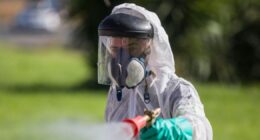
Tetsuya Yamagami Wiki
Tetsuya Yamagami Biography
Who is Tetsuya Yamagami ?
The suspect arrested for shooting Shinzo Abe believed that Abe was part of a “specific organization” that he had a grudge against.
Abe was killed Friday during a campaign event in western Japan by a gunman who opened fire on him from behind while he was making a campaign speech, an attack that stunned a nation with few gun control laws. strictest in the world.
His wife Akie bowed her head as the hearse left the hospital for the couple’s home in Tokyo.
When a hearse carrying Abe’s body arrived at his Tokyo residence, members of his ruling Liberal Democratic Party (LDP), dressed in black, lined up to pay their respects.
Current Prime Minister Fumio Kishida is expected to visit this afternoon.
Shot
Men and women were photographed crying and praying with flowers at a site outside Yamato-Saidaiji station in Nara, where Abe was shot.
Local media reports suggest that a night vigil will be held on Monday and that Abe’s funeral will take place on Tuesday.
Abe, 67, who was Japan’s longest-serving leader when he resigned in 2020, collapsed bleeding and was airlifted to a nearby hospital in Nara, though he was not breathing and his heart had stopped. .
Nara Medical University’s emergency department chief Hidetada Fukushima said Abe suffered serious heart damage, along with two neck injuries that damaged an artery. He never got his vital signs back.
Suspect Arrested
Police at the scene of the shooting arrested Tetsuya Yamagami, 41, a former member of the Japanese navy, on suspicion of murder.
Police said he used an obviously homemade gun, about 16 inches long, and confiscated his personal computer when they raided his nearby home.
Yamagami had amassed an arsenal of homemade weapons similar to the one used in the attack on his home, along with a series of explosives that were brought in to destroy them, police say.
It’s unclear exactly how he learned to make the weapons, but he is a veteran of the country’s defense forces and served in the Navy between 2002 and 2005.
Yamagami is currently unemployed and had traveled to Nara by train, waiting at the station where Mr. Abe was to give his speech before launching the attack. Cops have not said how long he waited.
A chilling image taken moments before Abe was killed shows Yamagami, an unassuming figure in a green T-shirt and cargo pants, loitering behind him.
Yamagami responded calmly to questions and admitted to attacking Abe, police said, telling investigators he had planned to kill him because he believed rumors about the former leader’s connection to a certain organization, which police did not identify.
A dramatic video from broadcaster NHK showed Abe standing and giving a speech outside a train station ahead of Sunday’s parliamentary elections.
As he raised his fist to indicate something, two shots rang out and he collapsed clutching his chest, blood stained his shirt as security guards ran towards him.
The guards then jumped on the gunman, who was face down on the pavement, and a double-barreled gun was seen nearby.
Prime Minister Fumio Kishida and his cabinet ministers rushed back to Tokyo from campaign events elsewhere after the shooting, which he called “cowardly and barbaric.”
Kishida promised that the election, which elects the least powerful members of Japan’s upper house of parliament, would go ahead as planned.
Attack
Abe was a leading figure in Japanese politics, serving two terms from 2006 to 2007, and then again from 2012 until ill health forced him to resign in 2020. He remained highly influential within the Liberal Democratic Party even after taking office. , and was in Nara. to support the local candidate before Sunday’s vote.
Current Prime Minister Fumio Kishida called the shooting an attack on “the foundations of democracy”, describing it as “heinous”, “barbaric and malicious” and “absolutely inexcusable”. “I would like to use the most extreme words available to condemn this act,” he added.
Video taken shortly before the shooting shows Abe arriving at the scene and waving to people before Yamagami steps out from behind a banner.
He walks behind the politician as he begins to speak before pulling the gun out of his bag and firing the first shot. He seems to miss Abe, who turns to look before the second fatal shot is fired.
Abe’s legacy will remain as perhaps the most important of Japan’s postwar leaders: a hard-line conservative and economic reformer who lifted the country out of decades of stagnant economic growth and turned it into a powerful player on the world stage.
Born into a political dynasty, Abe’s grandfather and great-uncle had been prime ministers before him and groomed him for power early on.
READ RELATED: McCrae Dowless useless and obituary, at heart of NC-9 scandal, dies of most cancers – reason behind demise
He first became a premiere in 2006 at the age of 52, the youngest ever to hold the position, but he was embroiled in a scandal and abruptly resigned after just a year while suffering from the debilitating intestinal condition ulcerative colitis.
He regained the role of prime minister in 2012 and held the post for the next eight years, making him Japan’s longest-serving prime minister, before being forced to resign again in 2020 when the intestinal condition resurfaced.
Abe is best known for his ‘Abenomics’ agenda to revive Japan’s sluggish economy through a program of big government spending, massive monetary easing and red tape reduction.
But he also pushed for reforms to Japan’s postwar pacifist constitution to allow the country to develop a full military and deepened ties with Western allies, particularly the US.
UK Prime Minister Boris Johnson paid tribute to Abe as news of his death broke on Friday, saying: “His global leadership of him through unknown times will be remembered by many.”
My thoughts are with his family, his friends, and the Japanese people. The UK stands with you at this dark and sad time.”
The attack came just before noon in the country’s western Nara region, where Abe had been making a speech with security present, but bystanders were able to get close to him easily.
Footage broadcast by NHK shows him standing on a stage as a man dressed in a gray shirt and brown pants begins to approach from behind, before pulling something out of a bag and shooting.
Apparently at least two shots were fired, each of which produced a cloud of smoke.
As onlookers and reporters ducked, a man was shown being tackled to the ground by security. He was later arrested on suspicion of attempted murder, according to reports.
Local media identified the man as Tetsuya Yamagami, 41, citing police sources, and several outlets described him as a former member of the Maritime Self-Defense Force, the country’s navy.
He was wielding a gun described by local media as a “handmade weapon,” and NHK said he told police after his arrest that he “pointed at Abe with the intent to kill him.”
Witnesses at the scene described the commotion as the political event descended into chaos.
“The first shot sounded like a toy bazooka,” a woman told NHK.
It didn’t fall off and there was a big bump. The second shot was more visible, you could see the spark and the smoke,” she added.
“After the second shot, people surrounded him and gave him a heart massage.”
Abe was bleeding from the neck, witnesses said and photos were shown. According to reports, he initially responded but subsequently lost consciousness.
Officials from the local chapter of Abe’s Liberal Democratic Party said there were no threats before the incident and his speech was publicly announced.
Kishida said “no decision had been made” on the election, although several parties announced that their main members would stop campaigning after the attack.
The attack caused international shock.
Family
He told reporters at the time that it was “heartbreaking” to leave so many of his goals unfinished. He spoke of his failure to solve the problem of Japanese kidnapped years ago by North Korea, a territorial dispute with Russia, and a revision of Japan’s renouncing war constitution.
That last goal was a big reason why he was such a divisive figure.
His ultra-nationalism angered the Koreas and China, and his push to normalize Japan’s defense posture angered many Japanese. Abe failed to achieve his cherished goal of formally rewriting the US-drafted anti-war constitution due to low public support.
Abe’s supporters said his legacy was a stronger US-Japan relationship aimed at bolstering Japan’s defense capabilities. But Abe also made enemies by forcing defense targets on himself and other contentious issues in parliament, despite strong public opposition.
Abe is a blue-blooded politician who was groomed to follow in the footsteps of his grandfather, former Prime Minister Nobusuke Kishi. His political rhetoric often focused on making Japan a “normal” and “beautiful” nation with a stronger military and a larger role in international affairs.
The US ambassador to Japan, Rahm Emanuel, expressed sadness and shock at the shooting. “Abe-san has been an outstanding leader of Japan and a staunch ally of the US. The US government and the American people are praying for the well-being of Abe-san, his family, and the people of Japan.” “he said on Twitter.
Tetsuya Yamagami Quick and Facts
- Shinzo Abe, 67, Japan’s former PM and a towering political figure, was shot dead while campaigning on Friday
- Abe, the country’s longest-serving leader, was shot twice as he gave a speech in the city of Nara at 11.30am
- Shocking video captures the moment of the attack, showing how the leader’s oblivious security guards were caught unawares by the first shot – which missed – and tried to block the second fatal round with briefcases
- Chilling photo also shows killer Tetsuya Yamagami calmly waiting behind Shinzo Abe as he prepares to attack
- GRAPHIC CONTENT WARNING: This story contains graphic content which some readers may find distressing
Source: https://wikisoon.com/




